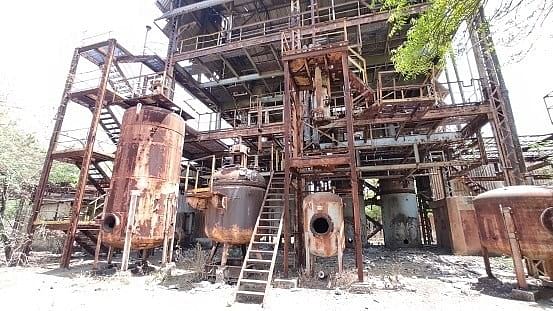
Representative image of the abandoned industrial site where gas leakage took place in Bhopal.
Credit: iStock Photo
New Delhi: Some locations near the Union Carbide’s pesticide plant continue to report high concentrations of heavy metals in the groundwater, four decades after the Bhopal Gas tragedy, according to a new report by the Central Ground Water Authority (CGWA).
In December last year, the National Green Tribunal (NGT) took suo motu cognizance of a media report spotlighting groundwater contamination risks from poorly managed toxic waste at the Union Carbide factory premises.
Subsequently, the CGWA initiated a new investigation to examine potential groundwater contamination near the Union Carbide India Limited (UCIL).
The study involved field surveys and laboratory investigations, with CGWA officials collecting 72 groundwater samples (36 samples each for basic parameters and heavy metals) from different directions within a five-km radius of UCIL.
The report submitted to the NGT on Thursday showed that nitrate concentrations exceeded the BIS desirable limit at seven out of 36 locations.
Phosphate levels exceeded World Health Organization (WHO) permissible limits at two locations. Some locations showed hardness with calcium and magnesium levels surpassing Bureau of Indian Standards (BIS) limits.
Sodium concentrations at two locations exceeded WHO standards. Potassium concentrations at 27.77 per cent of locations were above WHO limits, the CGWA said.
Nearly 99 per cent of the samples were categorised as hard or very hard water for household use, the CGWA said, adding that sulphate levels were below the BIS limit, while fluoride concentrations met the standards.
The findings revealed pH values within the permissible range, electrical conductivity of water below the BIS acceptable limit, and absence of carbonate ions.
Total alkalinity values were within limits, and chloride concentrations indicated partial pollution.
Iron concentrations breached BIS limits at eleven locations, reaching a maximum of 11.664 mg/l. Manganese pollution affected 8.33 per cent of locations, exceeding the BIS limit.
"Aluminium concentrations were reported within the BIS limit. Zinc contamination was minimal, with only one location exceeding the BIS-acceptable limit but remained under the permissible limit. Arsenic concentrations were generally below BIS limits, except for one location," the report read.
Other tested parameters, including silver, boron, molybdenum, nickel, copper, selenium, chromium, cadmium, barium, mercury, lead, and uranium, were within permissible limits.
Strontium, not regulated either by BIS or WHO standards, was reported at concentrations from '0.198' to 2,223 mg/l with an average of 0.833 mg/l.
On the night of December 2, 1984, an accident at the pesticide plant led to the leaking of at least 30 tons of a highly toxic gas called methyl isocyanate, and a number of other poisonous gases.
More than six lakh people were exposed to the deadly gas. Thousands died immediately after that accident, and tens of thousands more have died since. Government figures now refer to an estimate of 15,000 killed over the years.
Research shows that the disaster has burdened people who were born in the year after the accident with cancer, disabilities, and poverty even 40 years after the accident.